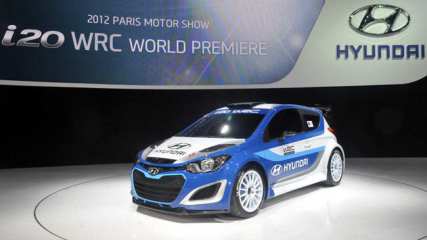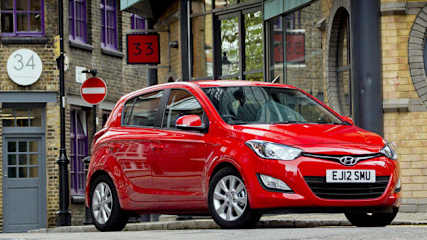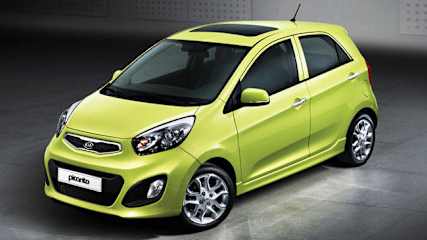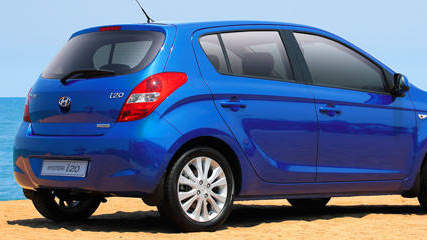Hyundai I20 2010 News
.jpg)
2017 Hyundai i20 WRC racer revealed in Paris | video
Read the article
By Peter Anderson · 29 Sep 2016
Hyundai's new i20-based rally challenger benefits from 2017 WRC rule changes.

Hyundai i20 WRC rally bid
Read the article
By Craig Duff · 28 Sep 2012
The South-Korean company previewed a three-door i20 WRC racer at this week’s Paris Motor Show and European marketing director Mark Hall says the class’s excitement and dynamism embodies Hyundai’s brand.
“Our participation will demonstrate Hyundai’s engineering excellence and desirability, and will also help to enhance our passenger vehicles in future,” Hall says.
Hyundai also unveiled a fuel-cell ix35 SUV that will be leased to private and fleet operators in Europe later this year. The company didn’t reveal prices but says the car can travel almost 600km between refills and the fuel cell generates around 75kW by converting hydrogen into electricity to feed a lithium polymer battery that powers the motor.
A three-door version of the i30 small car was also shown for the first time. It is exclusively for European markets - at least for now - and the sharply styled hatch will be sold with the choice of three diesel and three petrol engines mated to six-speed manual or automatic transmissions.

Hyundai i20 official images and details
Read the article
By Karla Pincott · 29 May 2012
The photos released in the UK overnight show clearly the facelift given to the little hatch, which now carries a new grille, headlights and front fascia design that more closely follows the styling of the new i30 – being launched and test-driven this week – as well as the Accent and Elantra.
The bonnet and front wing panels have also been updated, while the UK car also rolls on new wheel designs. Around the back, the real light clusters have also been redesigned and recontoured, sitting prouder from the body than in the previous version to add more shape.
Four drivetrains are available in Europe. The highlight is a new 55kW 1.1-litre, three-cylinder ‘U-II’ diesel engine that promises low carbon emissions of just 84g/km of CO2 -- less than a Toyota Prius and making the i20 one the lowest emitting diesel engines on sale, Hyundai said.
There is also a 66kW 1.4-litre four-cylinder ‘U-ll’ diesel engine that Hyundai says emits 96g/km CO2 , plus two petrol four-cylinder engines: a 62kW 1.2-litre and a 1.4-litre.
However we will continue with only the last of those four, the 74kW/146Nm 1.4-litre mated to either a five-speed manual or a four-speed automatic transmission.

Kia Picanto may come here
Read the article
By Paul Gover · 06 Jan 2011
The baby Picanto is being assessed for a starting spot in Australia as the next Rio, currently priced from $14,990, is moved a little higher in the line-up.
The Picanto would likely have a $13,000-ish bottom line with the larger Rio moving up beyond $15,000 with more safety and luxury equipment as standard.
"We're looking at it. It's not off the table," says Kia's Australian spokesman, Kevin Hepworth.
The five-door Picanto hatch is called a 'city car' by Kia and is revealed this week from Seoul ahead of its full-scale unveiling at the Geneva Motor Show in March.
Pictures from Kia show a car with the funky style that is becoming typical of the brand, with a chiseled nose and a compact body.
"New Picanto features significant sculpting and a very prominent rising character line. The result is a layering of light and shadow and this breaks up the height, giving the car a more sure-footed stance," says Kia's charismatic chief designer, Peter Schreyer.
Mechanically, the car is based on the Hyundai i20 that is already on sale in Australia. The i20 is priced from $15,490 with a 1.4-litre engine.
Kia says the Picanto is substantially different to the i20, and a significant improvement over the previous-generation Picanto that was passed up for Australian sales. It is larger than the earlier Picanto and is only likely to come as a five-door hatch, although there are plans for a three-door sporty model in Europe.
If the Picanto comes to Australia it will be built in Korea, but there is no hint yet on the mechanical package. The car is being built with both 1.0 and 1.2-litre engines, with LPG bio-flex and flex-fuel systems fitted for some countries.
Hepworth says Kia will make an early decision on any Picanto plan.
"If a decision is made to go forward with the vehicle, we would take it at the first opportunity. Possibly by the end of this year," he says.

COTY 2010 finalist Hyundai i20
Read the article
By CarsGuide team · 11 Nov 2010
HYUNDAI i20, from $15,490
Hyundai has packed a host of features and driving dynamics into the stylish i20, all at an attractive price with running costs that won't break the bank.
This is another example of Hyundai getting it right in a tough and competitive sector, although a recent $500 price hike dilutes the attraction marginally although bringing a six-airbag cabin to join the ESP, Bluetooth and iPod capability.

Hyundai i20 not here on price
Read the article
By Paul Gover · 14 Jul 2010
For the first time the Korean company is introducing an all-new baby car without putting the price first. The bottom line on the i20 tiddler is $$14,990 for the three-door ($15,990 for five-door, with automatic a $2000 addition) which puts it up above the top selling Getz that does most of its work as a $12,990 drive-away deal.The car will be built in Chennai, India, and there will be two petrol engines – a 1.4-litre and a 1.6-litre. "Without risk, nothing happens. But I think this is not risky, this is a good chance to make people understand our product," says Edward Lee, managing director of Hyundai Australia.Hyundai has the Getz as a safety net until it dies in the middle of 2011, and can also tap the tiny i10 from India if necessary, but Lee believes the time is right for Hyundai to dump its reputation as a price-is-everything company."We don't have to be a cheap brand. We want to give value, not just the price," says Lee. "We will deliver more value. Price is important, but value is more important."Lee admits Hyundai cannot match the low-price potential of incoming Chinese brands, and says he is watching Suzuki's successful efforts with its price from $12,490 Alto.But he is determined not to back down on the brand-building work which is making Hyundai the fastest improver in Australian showrooms. "I'm very confident we will create another good story through i20. We will challenge in this segment with our brand and product quality."Lee says the ix35 and i45 are both doing well without Hyundai's signature driveaway pricing and customers are even prepared to wait up to three months for cars."The customer database is quite different. This is the first time people want to wait for a Hyundai," he says. "With i20 I think we will get the same result. We plan to challenge with the brand, not the price."The i20 is being sold as both a three and five-door hatch, moving into the Hyundai line-up above the Getz and below the i30. By the end of next year there could be three all-new light-class contenders from Hyundai, with the i10 and another i20-sized car being built in Korea.But Lee says he will not fix a strategy - or plan introductions for the i10 or the still-secret newcomer - until he sees how the i20 is going. The initial sales target in Australia is 1000 cars a month, about half the sales rate of the Getz, building over time.

Japanese carmakers stumbling
Read the article
By Paul Gover · 10 Jun 2010
After leading the world on so many fronts - from quality to comfort and reliability - they have been hit badly by the global financial crisis. Toyota and Honda and many of the others wound back dramatically at the onset of the GFC, not just on their production lines but also in their motorsport programs - F1 was the first casualty - and new-product development.We are now seeing the results in Australian showrooms, where the Corolla and Civic are now mid-pack in the small-car class and former pacesetters including the Mazda6, Honda Accord Euro and even the locally-made Camry are struggling against newer and better rivals. They are fine for everyday transport, but not as impressive as they were just five years ago.Subaru has also cut costs and its latest styling work - particularly on the Liberty and Outback - reflects a desperate desire to win sales in the USA. Contrast all of them against the Suzuki Kizashi, which comes from one of the few Japanese brands that held its nerve through the GFT. Suzuki has cut its production targets, and admits that extra Kizashi models are on the back-burner, but is going to do brilliantly well with the car.Toyota and Honda, in contrast, are relying on value-added deals to keep customers coming in Australia. They are recovering from the economic downturn but nowhere near as rapidly as some of their rivals - particularly Hyundai.In Australia, many of our Japanese cars are now also actually built in Thailand. It's not a major drama, because the quality is much the same, but it shows how the battle to cut costs is influencing the Japanese makers. The Thai drive also shows that Japan Incorporated is now happy to produce bland transport modules instead of appealing cars, going for numbers first - in showrooms and on the balance sheet. It's a reasonable response to the GFC but is going to cause problems in coming years.Why? Because Australia is seeing so many classy European cars at more affordable prices - look at the Volkswagen Polo - and because Korean is coming up fast. Hyundai is now doing a better job than Toyota at building Toyota-style cars, with adventurous styling, classy quality and great prices. It's latest, the i45 replacement for the dowdy Sonata, is really good on every front except its awful steering and lacklustre front suspension.The i45 is a Camry done better and, like the Kizashi, one of the stars of 2010. And it's not the end for Hyundai, which has all sorts of new models coming from the baby i20 to an overdue sporty car sometime in 2012.And that's whan the Japanese really could be in trouble. It's not because Hyundai has something new but because the Japanese wound their development programs back during the GFT and the results of that conservative risk management will not really be known until we see - or don't see - the work which should have been done over the past two years.Follow Paul Gover on Twitter!

Launch pad a hot spot
Read the article
By Paul Gover · 20 May 2010
Three newcomers a week is way beyond the normal rate, even in a car world where 100-plus newcomers - everything from a facelift tweak to a full body change - hit showrooms each year. Things were a bit quiet through March and April, but when the calendar flicked across to May the ships started landing with fresh new metal to tantalise anyone with a taste for something new in the driveway.Everyone in the car business knows fresh metal is the best way to lure buyers into showrooms and, with demand running at near-record levels, the conversion rate right now is massive.Hyundai is doing huge business and this week it has the successor to the Sonata - now with a trendoid i45 badge on the boot to try and break the dowdy Sonata pattern - with the tiny Euro-focus i20 in June. We are also getting a first serious look at the Toyota Rukus, the first move in a plan to win Gen-Y buyers to the world's biggest brand, and Skoda has the station wagon stretch on its latest Superb. Did I mention we're also having a first fang in the Porsche 911 GT3 RS at Phillip Island this week?The real problem with so much new stuff is finding the space inside a weekly Carsguide. In today's edition we still have to clear the impressive new Suzuki Kizashi and the classy BMW 5 Series before we can move on to the next round. The other good news is that the cars we are seeing are all potential contenders for the Carsguide Car of the Year award.The Volkswagen Polo has already set the bar but the Kizashi will make the finals and so should the 5 Series. Later in the year we know Holden will have a VE Series II with star potential, Benz is about to uncork its Gullwing SLS, and the Jaguar XJ will arrive to take the British brand in a new direction.And that 911 RS? Not a COTY contender, but only because it is far too narrow focussed with a scorecard that reads 100 per cent for thrills and pace but closer to zero for value and people carrying potential.Follow Paul Gover on Twitter!

Hyundai ix35 may lift image
Read the article
By Kevin Hepworth · 21 Aug 2009
The company is closely guarding images of the new ix35 — the replacement for the Tucson compact SUV — until its official unveiling at the Frankfurt Motor Show next month but it will owe much of its styling to the sexy ix-onic Concept displayed at the Geneva show earlier this year.
"It is really attractive and it is closer in reality to its concept than a lot of others I have seen," Hyundai Australia's director for sales and marketing, Kevin McCann says. "I think, in that segment, people are starting to look for aesthetics. "They no longer want the chunky styling anymore but are looking for something that is sleek and fluid and slim-lined. This car certainly offers that."
The ix35 will also be the launch platform for a range of new technologies to Hyundai including stop and go engine management, a family of double-clutch gearboxes for the two- and four-wheel drive platform and at least one new 1.6-litre four-cylinder direct injection petrol engine with an impressive 130kW output.
"They are all things that we are looking at, although not everything is available to us," McCann says. "For example, ISG (idle engine stop/start) is only made in the Eastern European factory for the European market. "We would have to guarantee the factory in Korea sufficient demand for those items to justify them being made there, but that is something we are working on."
While McCann would not be specific about which engine, gearbox and drivetrain combinations would be offered in Australia he did confirm that the new generation engines were part of the planning along with the new generation of transmissions.
The Tucson is the company's third-best selling model behind the Getz and the i30 and McCann knows there can be no mistakes with its replacement when it arrives towards the middle of next year.
"The compact SUV segment is an important part of our volume base," McCann says. "We do very well there right now because we are at the lower end of the price band for those SUVs. I think there is a natural ceiling at which you can price a Tucson, but with the new ix35 we will be able to have a very solid entry-level competitor and the design of the car will enable us to offer a wider range across the price band. We will be able to richen our mix considerably with it."
That is likely to mean upward pressure on the larger Santa Fe, a heavily revised version of which will also be unveiled at the Frankfurt show. "This (the Santa Fe upgrade) is quite significant," McCann says. "We are respecifying some aspects of the car but I can't really give you the details of that right now."
If the highly-specified ix35 is moved up-market into a price-range currently occupied by an entry-level Santa Fe the outcome is likely to be an opportunity for Hyundai to offer the new Santa Fe in less models but with a higher level of standard inclusions.
The ix35 styling comes from the same team at the company's European design centre near Frankfurt which penned the i30. Speaking of the ix-onic concept in Geneva, design boss Thomas Buerkle said: "This is a dynamic sculpture ... it is an urban nomad. It is the new generation of SUV; a car of contrasts for a world of contrasts." Slightly larger than the Tucson at 4.4m long, the ix-onic was designed specifically for the European market with the target of younger buyers.

Hyundai i20 will be delayed
Read the article
By Kevin Hepworth · 03 Jul 2009
"There has not been too much forward progress ... it is still the subject of a fair bit of hard work and analysis," Hyundai Australia's director for sales and marketing, Kevin McCann, says. "We still have the strong intention to launch the car in the very near future but it is a very complex process.
"There was a decision made to get the car. That decision has not been unmade but we do have to get through some issues and challenges before we can implement it."
While insisting that the i20 will be launched as soon as possible, McCann concedes that the arrival of the small-car sibling to the company's highly successful i30 models could be delayed until the middle of next year.
"There is an outside risk that it could take that long — and I certainly wouldn't step back from that," McCann says. "The stated plan is still for later this year but that goal is becoming more elusive as time goes on."
The major stumbling block to getting the i20 — designed at Hyundai's Russelsheim studio in German and built at the Chennai plant in India — is negotiating a factory exit price that will keep the car competitive in the Australian market.
"It definitely comes down to the very tiny gap between the cost of the car (out of the factory) and the price of the car (in Australia)," McCann says. "We have said before that we see it as head to head with the volume end of the segment — that being the leading Japanese models (Toyota Yaris, Mazda2 and Honda Jazz) — and that continues to be the strategy. The Getz will remain a fixture at the price-leader end of the market."
McCann confirmed that for Australia, unlike most world markets where the i20 has replaced the Getz, the new model will take the place of the slow-selling Accent.
While conceding that the delays in the i20 were disappointing, McCann is adamant that Hyundai has not missed the boat with regard to the opportunity to leverage off the success of the i30.
"It is not a segment in which people will wait, but neither is it a segment where you will miss out on people forever if they choose not to wait," McCann says. "There are always new buyers coming into the market and I don't believe a delay of three or four months from the original plan is going to cause us to lose a volume opportunity.
"It is taking longer than we would want, but at the same time we have some other exciting new models that we will have to fit in as well."
One of the most crucial new models is the replacement for the Tucson compact SUV, the ix35 which will highlight the company's new design language as highlighted on the ix-onic concept car at the Geneva motor show earlier this year.
The ix35 is expected to arrive in Australia early next year after its official unveiling at the Frankfurt motor show in September.
Also due early next year is part of the next generation of the Sonata mid-sized car. The sleek sedan/coupe developed for the US market will be the first of the models to arrive and will be followed later in the year by the i50-badged sportwagon model developed specifically for European markets.
Towards the end of next year Hyundai is also expected to launch the sub-mini i10 into Australia.




